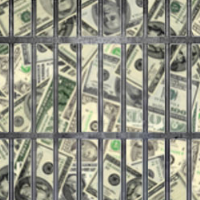Is Dramatic Increase in Number of Jailed Americans a Warped Version of Job Creation?
 (photo illustration: Steve Straehley, AllGov)
(photo illustration: Steve Straehley, AllGov)
One of Republicans’ favorite refrains is that “government doesn’t create jobs.” Well, government incarceration policies, it turns out, do create jobs and they don’t always show up on a jail’s payroll.
A report (pdf) from the Vera Institute of Justice pointed out some of the true costs of keeping people in locally run jails.
Jails are different than prisons in that they’re used by local law enforcement to incarcerate those waiting to be tried or those convicted of minor offenses serving relatively short sentences. They range from small rural facilities to systems in New York and Los Angeles that regularly house more than 10,000 inmates.
Correction officers make up a significant portion of the national workforce. According to federal government statistics, the ratio of correction officers to prisoners has remained at about 3.3 to 1 over the past 30 years. However, the number of inmates has more than tripled from 223,551 in 1983 to 735,601 in 2011.
According to the Bureau of Labor Statistics, there are currently about 163,000 local correctional officers in the United States.
Vera’s report pointed out that the more prisoners there are, the more people must be paid to keep an eye on them. Looking at similar-sized counties, Johnson County, Kansas, a suburb of Kansas City, and Bernalillo County, New Mexico, which contains Albuquerque, Vera found that Johnson County spent much less per county resident on jails, mainly because it incarcerates fewer people. Johnson County spends $82 per county resident, Bernalillo County $113. About 75% of jail costs go to salaries and benefits, the survey found.
In addition to direct jail costs, other expenses are often spread throughout a county’s budget. These can include IT support, human resources and payroll functions and pensions and health insurance. All these costs add to the taxpayer burden for paying for a jail population that continues to increase.
It’s not as easy as it seems to reduce costs, however. Some costs drop as the inmate count decreases, but staffing can’t usually be cut until a portion of a facility is closed, eliminating the need for any guards there.
Most costs can’t be cut by the jails themselves. Instead, “only by widening the lens—looking beyond the jail to the decisions made by police, prosecutors, judges, and community corrections officials—will jurisdictions be able to significantly reduce the size of their jails, save scarce county and municipal resources, and make the necessary community reinvestments to address the health and social service needs that have for too long landed at the doorstep of the jail,” the report concludes.
-Steve Straehley
To Learn More:
The Price of Jails: Measuring the Taxpayer Cost of Local Incarceration (Vera Institute of Justice) (pdf)
Occupational Employment and Wages, May 2014—Correctional Officers and Jailers (Bureau of Labor Statistics)
Who’s Funding the Anti-Marijuana Movement? Private Prisons, Prison Guards, Police and Alcohol, Beer and Pharmaceutical Companies (by Noel Brinkerhoff, AllGov)
- Top Stories
- Unusual News
- Where is the Money Going?
- Controversies
- U.S. and the World
- Appointments and Resignations
- Latest News
- Trump to Stop Deportations If…
- Trump Denounces World Series
- What If China Invaded the United States?
- Donald Trump Has a Mental Health Problem and It Has a Name
- Trump Goes on Renaming Frenzy






Comments